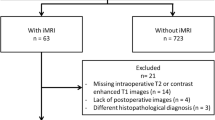Summary
The purpose of this study was to assess the role of MR imaging and the paramagnetic contrast agent Gadolinium-DTPA(Gd-DTPA) in the diagnosis of pituitary macroadenomas. 44 macroadenomas were examined with MRI before and after intravenous application of Gd-DTPA. Gd-DTPA produced excellent enhancement of solid adenoma. The best contrast between adenoma and surrounding structures could be gained on post-Gd T1-weighted images. Post-Gd images were equivalent to pre-Gd images in the evaluation of supra-and infrasellar extensions of macroadenomas. Post-Gd images had advantages in the evaluation of cavernous sinus invasion by adenoma. The difference in degree of contrast enhancement between adenoma and cavernous sinus facilitated the exact evaluation of lateral extension by adenoma in 18 cases. Almost equal degree of enhancement of both structures impaired tumor-sinus contrast in 2 cases. In the other 24 cases the tumor filled the cavernous sinus completely. It is our opinion that Gd-DTPA can be used on a widespread basis because of its excellent capability to highlight and delineate pituitary adenomas.
Similar content being viewed by others
References
Kucharczyk W, David DO, Kelly WM, Sze G, Norman D, Newton TH (1986) Pituitary adenomas: High-resolution MR imaging at 1.5T. Radiology 161:761–765
Brant-Zawadzki M, Norman D (1987) Magnetic resonance imaging of the central nervous system. Raven, New York. pp 187–208
Davis PC, Hoffman JC Jr, Spencer T, Tindall GT, Braun IF (1987) MR imaging of pituitary adenoma: CT, clinical, and surgical correlation. AJR 148:797–802
Schneider GH, Vogler E (1988) Digitale bildgebende Verfahren Interventionelle Verfahren Integrierte digitale Radiologie. Springer, Berlin Heidelberg, New York, pp 54–62
Lissner J, Seiderer M (1987) Klinische Kernspintomographie. Enke, Stuttgart, pp 177–193
Lee SH, Rao KCVG (1987) Cranial computed tomography and MRI. McGraw-Hill, New York, pp 445–477
Daniels DL, Haughton VM, Naidich TP (1987) Granial and spinal magnet resonance imaging. Raven, New York, pp 121–158
Stark DD, Bradley WG Jr (1988) Magnetic resonance imaging. Mosby, St. Louis, pp 524–569
Karnaze MG, Sartor K, Winthrop JD, Gado MH, Hodges FJ III (1986) Suprasellar lesions: Evaluation with MR imaging. Radiology 161:77–82
Sartor K, Karnaze MG, Winthrop JD, Gado M, Hodges FJ III (1987) MR imaging in intra-, para- and retrosellar mass lesions. Neuroradiology 29:19–29
Taveras JM, Ferrucci JT (1987) Radiology. Lippincott, Philadelphia, pp 1–11
Schörner W, Kazner E, Laniado M, Sprung C, Felix R (1984) Magnet resonance tomography (MRT) of intracranial tumors: Initial experience with the use of the contrast medium Gadolinium-DTPA. Neurosurt Rev 7:303–312
Runge VM, Claussen C, Felix R, James AE Jr (1986) Contrast agents in magnetic resonance imaging. Excerpta Media, Amsterdam, pp 106–117
Brant-Zawadzki M, Berry I, Ozaki L, Brasch R, Murovic J, Norman D (1986) Gd-DTPA in clinical MR of the brain: 1.Intraaxial lesions. AJR 147:1223–1230
Berry I, Brant-Zawadzki M, Ozaki L, Brasch R, Murovic J, Newton TH (1986) Gd-DTPA in clinical MR of the brain: 2. Extraaxial lesions and normal structures. AJR 147: 1231–1235
Breger RK, Papke RA, Pojunas KW, Haughton VM, Williams AL, Daniels DL (1987) Benign extraaxial tumors: Contrast enhancement with Gd-DTPA. Radiology 163:427–429
Stark DD, Bradley WG (1988) Magnet resonance imaging. Mosby, St. Louis, pp 182–200
Schörner W, Sander B, Kommesser W, Laniado M, Nakamura T, Felix R (1988) Eine Mehrschicht-Gradientecho-Sequenz für die kontrastmittelunterstützte MR-Diagnostik intrakranieller Tumoren. Fortschr Röntgenstr 148:665–673
Kilgore DP, Breger RK, Daniels DL, Pojunas KW, Williams AL, Haughton VM (1986) Cranial tissues: Normal MR appearance after intravenous injection of Gd-DTPA. Radiology 160:757–761
Davis PC, Hoffman JC Jr, Malko JA, Tindall GT, Takei Y, Avruch L, Braun IF (1987) Gadolinium-DTPA and MR imaging of pituitary adenoma: A preliminary report. AJNR 8: 817–823
Haughton VM, Rimm AA, Czervionke LF, Berger RK, Fisher ME, Papke RA, Hendrix LE, Strother CM, Turski PA, Williams AL, Daniels DL (1988) Sensitivity of Gd-DTPA-enhanced MR imaging of benign extraaxial tumors. Radiology 166:829–833
Author information
Authors and Affiliations
Rights and permissions
About this article
Cite this article
Nakamura, T., Schörner, W., Bittner, R.C. et al. The value of paramagnetic contrast agent gadolinium-DTPA in the diagnosis of pituitary adenomas. Neuroradiology 30, 481–486 (1988). https://doi.org/10.1007/BF00339687
Received:
Issue Date:
DOI: https://doi.org/10.1007/BF00339687




